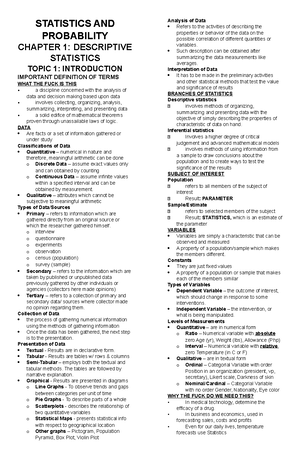- Information
- AI Chat
Was this document helpful?
Applied-Economics 2 - Lecture notes 2
Course: Accountancy (FMAN2)
157 Documents
Students shared 157 documents in this course
University: St. Paul University Quezon City
Was this document helpful?

MICROECONOMICS
Lesson 1: Basic Economic Concepts
Why Study Economics?
Economics is an integral part of our everyday life and it affects
our daily life.
Understanding economics, human beings become better
informed and better equipped to analyze the human behavior.
Economics allows us to intelligently and confidently debate on
government policies and consequences.
What is Economics?
A social science concerned with using scarce resources to obtain
maximum satisfaction of the unlimited material wants of society
(Walstad and Bingham).
The study of how societies use scarce resources to produce
valuable commodities and distribute them among different
people (Samuelson and Nordhaus).
A social science concerned with using scarce resources to obtain
the maximum satisfaction of the unlimited material wants of
society (McConnell and Brue).
The study of how people use their limited resources to try to
satisfy unlimited wants (Parkin and Bade).
Economics and Scarcity
Economics is a social science that studies the allocation of
scarce resources to satisfy unlimited human wants.
Economics came from the Greek word oikonomia, which means
“household management.”
Allocation means making decisions about choices.
Scarcity refers to a condition wherein most things that people
want are available only in limited supply.
Why Economics is a Science?
Neville Keynes defines it as “a body of knowledge concerning
what is.”
It enables to explain different situations, experiences and
occurrences.
It examines the activities of consumers, producers, and the
governments how the resources are allocated.
It applies a framework or a way of thinking to interpret,
understand and make conclusions about certain facts, figures
and phenomena.
Economics is a social science because it deals with human
behavior through its theory of how people make choices. It
seeks to explain the “why” of things in the world of economic
behavior – production, consumption, and distribution.
The Economic Resources
Land – one of the factors of production that include land and
natural resources.
Labor – basic factor of production which are productive services
embodied in human physical effort, skill, intellectual
powers, and others.
Capital - refers to durable goods to produce another goods.
(buildings, plant and machinery, roads, computers, ships
and many more)
Entrepreneurial ability - is the ability to use the three factors of
production to produce the required goods and services.
The brains behind the business
Note: There is no such thing as a noneconomic resource.
Everything is economical (including air)
Economic Models
A main tool used by economists to explain economic
phenomena.
They use economic variables to explain relationships.
ŷ = a + bx + e
Where ŷ = is the predicted value (dependent variable)
a = y - axis intercept (constant value)
b = slope of the regression
x = activity (independent variable)
e = error term
Models are simplifications of reality.
The ultimate test of the validity of an economic model is not
how close it can depict reality but how accurate it can predict
real-world events.
Best Example: Law of Supply and Demand
Common Phrases
1. Ceteris paribus assumption (other things being equal/constant).
2. The assertion that economic agents are optimizers (they want to
make the most of everything).
3. The distinction between normative and positive economics.
Positive economics – explanation of economic phenomena
Normative economics – the application of positive
economics to create policy
Economic Goals
1. Economic growth – high standard of living translated which is
translated into the production of more and better quality of
goods and services.
2. Full employment – there must be an available job for individuals
who are willing and able to work
3. Economic efficiency – makes use of the resources to maximize
the benefit for the society.
4. Price level stability – it able to avoid huge price fluctuation.
5. Economic freedom – freedom to do any economic activity;
engaging into the exchange of goods.
6. An equitable distribution of income
7. Economic security
8. Balance of trade
Types of Economic Systems
Capitalism.
An economic system mainly characterized by private individuals
owning and operating the majority of businesses that produce
goods and services.
Pure Capitalism - no government intervention
-competition determine the good and services needed by the
society
-survival of the fittest
Modified capitalism - has government intervention
-regulates business to certain extent
Rights of capitalism
Private property
Profits
Business decisions
Choice
Communism.
A society in which the government owns all the nation’s
resources. The exact opposite of capitalism.
Socialism.
The government owns and operates the basic industries.
(transportation, communications, water service, banking and
other selected manufacturing business) It is the government will
decide what goods and services to produce, how to produce and
how they are distributed.
A good example on what this does is an election.
Mixed
It has elements of more than one economic system.
The economic problems are answered predominantly by the
price mechanism and modified through government
intervention.
Classification of Economics
Microeconomics
Is the study of how individual consumers and firms behave, and
how the market system allocates scarce resources.
It does not concern itself to the temporary fluctuations in the
economy.
Also known as Price Theory
Macroeconomics
Studies the economy as a whole.
Seeks to explain why fluctuations happen and then investigate
policies that can mitigate them.
Studies four essential phenomena of the economy. All of which
rely on the interactions of the goods, labor, and assets markets of
the economy.
ounemployment – people capable of work but no job
oinflation – increase of value of monies
opoverty – what the poor people are suffering
ogrowth – of the entire economy
GDP (Gross Domestic Product) – made in country
Example: Mcdo sa Pinas
GNP (Gross National Product) – made by country
Example: Jollibee sa USA
Lesson 2: Principles of Economics
10 Principles of Economics (Expounded)
How People Make Decisions










